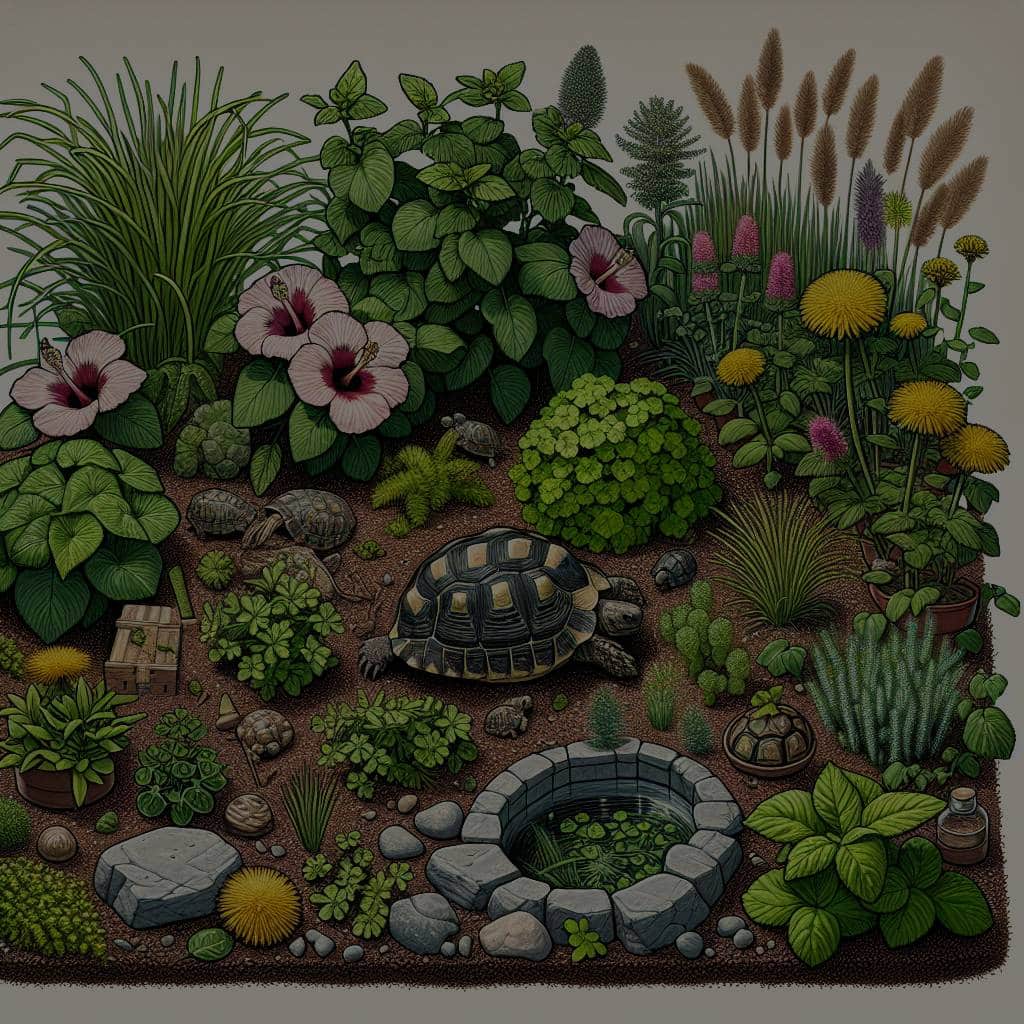What Are the Best Plants to Include in a Tortoise’s Habitat?

The world of tortoises is vibrant and diverse, where each species has unique dietary requirements. Creating a balanced habitat within their enclosure is essential for their wellbeing and longevity. This habitat must cater not only to their physical needs but also to their dietary requirements. Plants form a significant part of the food source for tortoises and hence, choosing the right ones to grow in their enclosures becomes crucial. This article covers the best plants to include in a tortoise’s habitat, considering their safety, nutritional value, and how easy they are to grow, along with insights into the desert and tortoise species available on Amazon.
Plants that Tortoises Will Love to Eat
Tortoises are primarily herbivores and rely heavily on plants for their nutrition. However, not all plants are safe or suitable for them to eat. Let’s delve into which plants and flowers are top choices for your pet tortoise.
In parallel : How to Care for a Persian Cat’s Unique Grooming Needs?
Grasses and Leaves
Grasses are a tortoise’s staple food. Grasses such as Timothy, Bermuda, and Orchard provide roughage that aids in digestion. Leaves like dandelion, clover, and plantain are also safe and nutritious for your pet. Apart from these, there are several other leafy veggies like kale, spinach, and lettuce that are suitable for tortoises. But remember, while these are good, they should only make up a small portion of their diet as they can be high in oxalic acid, which may cause health issues when eaten in large amounts.
Flowers
Flowers not only add color to a tortoise’s enclosure but also serve as a delightful treat. Tortoises can safely eat flowers like hibiscus, marigold, and roses. Ensure the flowers are organic and free from pesticides to prevent any harmful effects.
Also to read : What’s the Best Strategy for Introducing a Dog to Boating Activities?
What to Grow in Your Tortoise’s Enclosure?
Just as it’s important to understand what tortoises can eat, it is equally critical to know what to grow in their enclosure. It’s not just about what they will eat, but also what will thrive in their habitat.
Desert Plants
If you have a desert tortoise species, opt for plants that can thrive in dry conditions. Some top choices include the spineless prickly pear cactus and the globe mallow. The former, while providing shade and shelter, also offers a nutritious food source. The latter, with its bright orange flowers, will be a treat for the eyes and the palate.
Grasses and Flowers
As mentioned earlier, grasses are the mainstay of a tortoise’s diet. Growing them within the enclosure ensures a constant and fresh supply. Some species of tortoises also enjoy nibbling on flowers, so consider planting some of their favorites in the enclosure.
Amazon’s Top Picks for Tortoise Plants
For those of you who prefer online shopping, Amazon offers a wide range of plants that are safe and beneficial for tortoises. Here are a few top picks:
Zoo Med Tortoise & Box Turtle Flower Food Topper
This product is a blend of dried flowers, a favorite among many tortoise species. It provides a great way to add variety and enrichment to your pet’s diet.
Tortoise Forage Mix Seeds
These seeds, once sown, grow into a tortoise’s favorite grasses and flowers. An easy and economical way to ensure a steady supply of fresh food for your pet.
A Note on Safety
While it’s important to provide a variety of plants for your tortoise to eat, safety should always be a priority. Some plants and flowers can be toxic to tortoises, so it’s essential to double-check their safety before introducing them into the enclosure.
Also, always ensure the plants are free from pesticides and other chemicals. These substances can be harmful or even fatal to tortoises. If you’re unsure about a plant’s safety, it’s best to err on the side of caution and avoid it.
In conclusion, plants play a crucial role in a tortoise’s diet and habitat. Choosing the right ones will boost their health and enrich their environment. Whether you’re shopping online on Amazon or at a local nursery, keep in mind your tortoise’s species and individual preferences. Most importantly, remember to ensure the plants’ safety before bringing them home to your pet’s enclosure.
What You Should Avoid Planting in a Tortoise’s Enclosure?
While there are plenty of flowers and leaves that will make excellent additions to your tortoise’s diet, some plants are toxic and should be avoided. Providing a safe and nourishing environment for your tortoise means knowing which plants can be harmful to them.
Toxic plants
Some popular garden and house plants can be toxic to tortoises. These include plants such as ivy, foxglove, buttercup, and daffodils. While these may look pretty and are easy to grow, they are harmful if ingested by tortoises.
Non-edible plants
Not all non-toxic plants are suitable for a tortoise enclosure. Some may not be harmful if consumed, but they offer little nutritional value. Such plants include succulents like aloe vera. While aloe vera is not poisonous to tortoises, it is also not particularly beneficial to their diet.
Fruits and vegetables
While it’s okay to occasionally feed your tortoise fruits and some vegetables, be mindful that these should not make up the majority of their diet, as they can lead to health issues. For instance, an excess of fruit can lead to diarrhea, while some vegetables like potatoes and rhubarb leaves are outright toxic.
Maintaining a Balanced Diet for Your Tortoise
Maintaining a balanced diet for your tortoise is crucial for its health and longevity. Different species of tortoises, such as desert tortoises or Russian tortoises, have different dietary requirements. However, a general rule of thumb is to provide a diet that is high in fiber and calcium and low in protein and fat.
Essential nutrients
Leaves and flowers from plants such as dandelion, prickly pear, and hibiscus can provide a good source of nutrients. These plants can be regularly included in your tortoise’s diet. However, it’s also important to supplement their diet with calcium and vitamin D3, which can be obtained through a balanced commercial diet.
Live plants for stimulation
Including live plants in the tortoise habitat not only provides a food source but also serves to stimulate your pet. The act of grazing and exploring their habitat is a form of physical and mental activity, contributing to your tortoise’s overall wellbeing.
Water
While tortoises get a lot of their hydration from the plants they eat, it’s essential to provide a water dish in the enclosure. The water dish should be shallow to prevent the tortoise from flipping over in it.
In conclusion, creating the perfect habitat for your tortoise involves carefully choosing the plants to include in their diet and their environment. The best plants are those that provide nutritional value, are safe for consumption, and contribute to creating a stimulating environment. Avoid plants that are toxic or offer little nutritional value. Always remember, what you feed your tortoise or plant in its enclosure plays a significant role in its health, happiness, and longevity. So, choose wisely and continue learning about what is best for your little friend.
